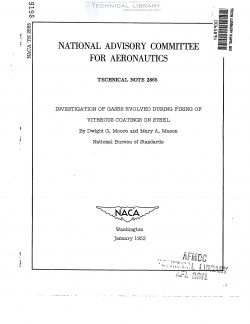naca-tn-2865
- Version
- 108 Downloads
- 1.39 MB File Size
- 1 File Count
- January 20, 2017 Create Date
- January 20, 2017 Last Updated
National Advisory Committee for Aeronautics, Technical Notes - Investigation of Gases Evolved During Firing of Vitreous Coatings on Steel

An investigation was made of the gases evolved during the firing of
vitreous coatings. The scope of the investigation included: (1) Exami-
nation of gas evolution with a microscope while specimens were being
fired, (2) examination of fired specimens for changes in bubble structure
with firing time, (3) examination of changes in normal gas evolution when
water—free enamels were used, (A) analysis with the mass spectrometer of
gases trapped in the bubble structure after varying firing times,
(5) determination of the source of carbon gases in the bubble structure
using radio-active carbon (Clh) as a tracer, and (6) determination of the
effect of various pretreatments of the clay used for suspending the
coating slip on the resulting bubble structure of the fired specimens.
The results showed that the principal gases evolved during the
firing were carbon monoxide, carbon dioxide, and hydrogen. The blis-.
tering that is often observed in the early stage of firing when vitreous
coatings are applied to low-carbon steel was found to be caused by evo—
lution of the carbon gases formed by the oxidation of the carbon in the
steel. Evidence was obtained that the hydrogen formed from the reaction
between the dissolved water in the coating and the hot iron base slowly
diffuses into the coating as the firing continues. Some of the hydrogen
also diffuses into the metal. On fast cooling this hydrogen is expelled
causing bubbles to form in the coating at the interface. It was found
that practically all of the bubble structure in a normally fired enamel
is due to some impurity in the clay mill addition. The impurity is prob—
ably organic matter adsorbed on the clay particles.
Gases are normally evolved when porcelain enamels are applied to
low-carbdn steel. The effects of the evolution sometimes are evidenced
by blisters and pin holes on the fired ware but more often by changes in
the bubble structure of the coating. In addition, such gases as hydrogen
and carbon monoxide when evolved during firing are capable of producing
changes in the oxidation state of metallic oxides present in the coating
layer and such changes could in turn affect the adherence.
| File | Action |
|---|---|
| naca-tn-2865 Investigation of Gases Evolved During Firing of Vitreous Coatings on Steel.pdf | Download |

Comment On This Post